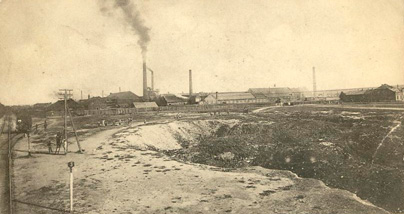How a small village in the steppe turned into one of the industrial centers of Eastern Ukraine thanks to Belgium.
It all started in 1895, when the joint-stock company Verreries et Usines chimigues du Donets a Santourinovka was established in Brussels (Belgium) at rue deFericho, 9, with a capital of 5.5 million francs. The board issued 22,000 shares of 250 francs each and bought from the owner of the village of Santurinivka, the Greek Nomikosov, 210 acres of land for 6,756.75 rubles in gold. During 1896-1900, the Belgians built glass, bottle, chemical, mirror and ceramic factories here, which worked throughout the 20th century.
The glass industry in Belgium had a national character, the center of which was the city of Charleroi, where 50 glass and mirror factories worked, producing products that were unique at the time. The owner of the factories was the well-known and respected Lambert family in Belgium – father Louis and his son Fernan. They became the founders and members of the Society’s Management Board, which included Louis Lambert, I. Cizele, and E. Depré. E. Pierre Goble became the Chairman of the Board. Fernand Lambert became the director of factories in Santurinivka.
The glass factory produced white, frosted, patterned and colored window glass of various sizes. 725 workers worked here (in Soviet times, the well-known enterprise “AVTOSKLO”). At the bottling plant, 1,200 workers produced up to 40 million bottles for various drinks – vodka, wine, champagne – as well as pharmacy and household utensils. The history of the factory tells us an interesting fact: during Soviet times, the factory produced 170 million (!) bottles of champagne wines every year, which was 90% of all production in the USSR! A small chemical plant produced various acids, chlorinated lime, etc. In 1912, 4,125 workers worked at three factories, the annual production was 6 million rubles. Many Belgian craftsmen worked at the factory and organized a brass band.
At the exhibition in Katerynoslav in 1910, the glass factory exhibited high-quality and interesting items of its production. The exhibit here was a glass pavilion in which everything – walls, roof, windows, doors – was made of multi-colored glass. Large glass cylinders, pyramids of bottles, etc. were displayed around the pavilion.
The company’s capital grew annually and in 1919 amounted to 17.9 million francs.
Сompagnie GLACES du Midi de la Russie – Mirror factories in the South of Russia was founded in 1900 in the city of Charleroi with a capital of 6 million francs (24,000 shares of 250 francs each). Louis Lambert became the Chairman of the Board. In 1900, the mirror factory started working in the village. New settlement of Santuryn Volost. The factory produced the highest quality mirrors and mirror glass. The plant had its own track to Art. Kostyantynivka. At the Exhibition in Katerynoslav, the plant exhibited a huge mirror several fathoms (fathoms – 2.13 m) in height and width and made a spectacular, almost fabulous impression!
The company remained on the industrial market until 1924, issuing shares in Brussels at 250 francs, and the capital increased to 18 million 250 thousand francs!
In 1896, also in Brussels, Sosiete anonyme TOLERIES de KONSTANTINOWKA – Iron Rolling Mills in Konstantinowka was founded with a capital of 4 million francs. The founder of the company was the Antwerp businessman J. Sizele. The Kostyantyniv factory was put into operation in 1896, and starting from 1897, it annually received a significant industrial profit, even in times of crisis. 1,500 workers worked at iron rolling mills with blast furnaces and martenov furnaces, producing iron, rail fasteners, springs, etc. Lithuania for 5.5 million rubles and brought great profits to shareholders (in Soviet times – the Kostyantyniv Metallurgical Plant in the Donetsk region).
The most recent enterprise in Konstantinovka was the company of the construction industry – CIMENTS PORTLAND DE KONSTANTINOFKA – Portland cement company in Konstantinovka with a capital of 3 million francs and founders’ shares. On the shares of the company in the museum collection, on the left, the signature of the founder and chairman of the Board Louis Lambert, already known to us from the glass factories. The cement plant was located near St. Kramatorsk of the Southern Railway.
This is the story of the Belgian investment in the modern city of Kostyantynivka of the Donetsk region, which was actually founded by the Belgians, before the independence of Ukraine. Securities, photos, documentary materials of the museum collection are confirmation of this history.
The column is run by Valentina Lazebnyk, head. department of the history of Ukraine and the region in the 14th and early 20th centuries.


